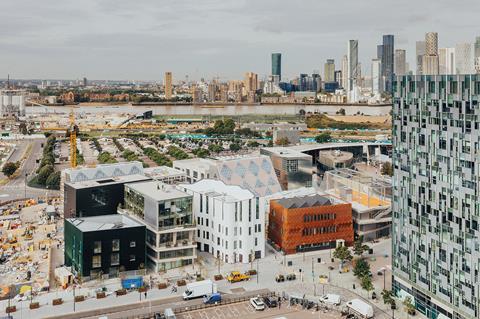- News

All the latest updates on building safety reformRegulations latest
- Focus
- Home
- News
- Focus
- Comment
- Events
- CPD
- Building the Future
- Jobs
- Data
- Subscribe
- Building Boardroom
Gather round: Greenwich Design District
By Thomas Lane2022-07-14T05:00:00

Source: Taran Wilkhu
Mole’s Victorian warehouse-inspired timber buildings really stand out among the low-cost rental studio spaces designed for creative industries

Source: Taran Wilkhu
The Greenwich Design District was designed by eight different small architectural practices to ensure each building had a unique identity. Narrow passageways and courtyards give the area an intimate feel. It offers studio space at low rates and is now mostly let
Such is the success of the new Greenwich Design District, the creatives wanting a small studio space must join a waiting list. Located on the Greenwich Peninsula, the developer Knight Dragon announced in 2017 that it was commissioning eight small architects to design a new district for artists close to the O2 and North Greenwich Tube station. Seen by some as a cynical ploy to make the area more appealing to potential buyers by giving it a creative buzz, the district is now finished and is indeed buzzing. It demonstrates that the idea can work given the right type of space coupled with cheap rents.
Unlike the high-rise housing blocks surrounding the design district, this consists of buildings no more than four storeys high packed closely together to give the district an intimate feel. The blocks are mostly muted in appearance, being finished in materials including brick, concrete, aluminium and stainless steel. Two buildings stand out in this largely monochrome landscape, one clad in an orangey-brown Corten weathering steel and the other a vivid green which shifts to a bluer shade depending on how the light is falling. These two buildings also happen to be the only ones constructed from timber.
Designed by Mole Architects, the timber buildings were carefully modelled and designed to minimise embodied carbon and ensure that they would not overheat, a potential problem with lightweight construction and increasing summer temperatures. Now fully occupied, the realities of the different demands of a diverse community mean one of the buildings has been radically altered due to the specific requirements of the tenants. How flexible are these buildings and how are they performing 10 months after the design district formally opened?
…
Already registered? Login here
To continue enjoying Building.co.uk, sign up for free guest access
Existing subscriber? LOGIN
Stay at the forefront of thought leadership with news and analysis from award-winning journalists. Enjoy company features, CEO interviews, architectural reviews, technical project know-how and the latest innovations.
- Limited access to building.co.uk
- Breaking industry news as it happens
- Breaking, daily and weekly e-newsletters
Get your free guest access SIGN UP TODAY

Subscribe now for unlimited access
Subscribe to Building today and you will benefit from:
- Unlimited access to all stories including expert analysis and comment from industry leaders
- Our league tables, cost models and economics data
- Our online archive of over 10,000 articles
- Building magazine digital editions
- Building magazine print editions
- Printed/digital supplements
Subscribe now for unlimited access.
View our subscription options and join our community


















